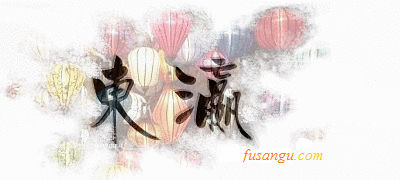Tokyo is served by an excellent mass transit railway network. The subway lines offer a cheap and comfortable way of getting around and you can basically reach any area and sightseeing place by solely relying on this network.
Furthermore, the network is so dense that you can easily spend entire days of sightseeing by only travelling along a single line.
In this page we list major sightseeing itineraries associated to each subway lines.
If you are in Tokyo for few days (2-3) you will most likely choose the subway as means of transport for your sightseeing tours.
Depending on the location of your hotel, you might have to use 2-3 subway lines for every day-tour. Having to use more than 3 lines in general has to be considered indicative of poor organisation.
Especially if you visit the city for the first time, it is best to choose easy to organise tours, that require a low number of transfers. Using subway discount day passes simplifies transfer itineraries, as this spares the nuisance of having to buy a ticket for every ride (which is the case if you switch from lines managed by different operators).
To further simplify the organisation, you can consider itineraries that require travelling only on one line.
Single subway line itineraries
Below we indicated the main sightseeing areas and places of interest served by the 13 subway lines that constitute Tokyo’s mass transit system:
-
Line 1 (Asakusa Line): Oshiage, Asakusa, Nihombashi, Shimbashi, Takanawa, Ota;
-
Line 2 (Hibiya Line): Minami-Senju, Ueno, Akihabara, Chuo, Roppongi, Naka-Meguro;
-
Line 3 (Ginza Line): Asakusa, Ueno, Ginza, Akasaka, Shibuya;
-
Line 4 (Marunouchi Line): Ikebukuro, Bunkyo, Chiyoda, Chuo, Akasaka, Yotsuya, Shinjuku;
-
Line 5 (Tozai Line): Funabashi, Edogawa, Nihombashi, Chiyoda, Iidabashi, Kagurazaka, Takadanobaba, Nakano;
-
Line 6 (Mita Line): Sugamo, Bunkyo, Chiyoda, Takanawa, Meguro;
-
Line 7 (Namboku Line): Komagome, Bunkyo, Iidabashi, Akasaka, Meguro;
-
Line 8 (Yurakucho Line): Ikebukuro, Iidabashi, Minato, Yurakucho, Ginza, Toyosu;
-
Line 9 (Chiyoda Line): Kita-Senju, Nippori, Yushima, Chiyoda, Harajuku, Yoyogi;
-
Line 10 (Shinjuku Line): Shinjuku, Bunkyo, Akihabara, Morishita, Ichikawa;
-
Line 11 (Hanzomon Line): Oshiage, Ryogoku, Chiyoda, Shibuya;
-
Line 12 (Oedo Line): Shinjuku, Bunkyo, Taito, Sumida, Koto, Chuo, Minato;
-
Line 13 (Fukutoshin Line): Ikebukuro, Shinjuku, Shibuya.
Some lines are particularly useful as an entire journey could be organised by relying almost exclusively on 2 or 3. These are the following:
-
Ginza and Fukutoshin Line, which connect all the areas normally visited on a Tokyo 3-day itinerary (i.e. Asakusa, Ueno, Shibuya, Shinjuku);
-
Chiyoda Line, which connects the northern districts of Adachi and Arakawa, ideal places where to find a cheap accommodation solution for long stays, and the centre. You could easily spend 4-5 days exploring only locations along this line or in its immediate vicinity;
- Oedo Line, which runs along a semicircular route connecting most of Tokyo's most interesting neighbourhoods.
Descriptions of well-balanced itineraries along Tokyo's subway lines in the following pages:
-
Asakusa Line | Hibiya Line | Ginza Line | Marunouchi Line | Tozai Line | Mita Line | Namboku Line | Yurakucho Line | Chiyoda Line | Shinjuku Line | Hanzomon Line | Oedo Line | Fukutoshin Line
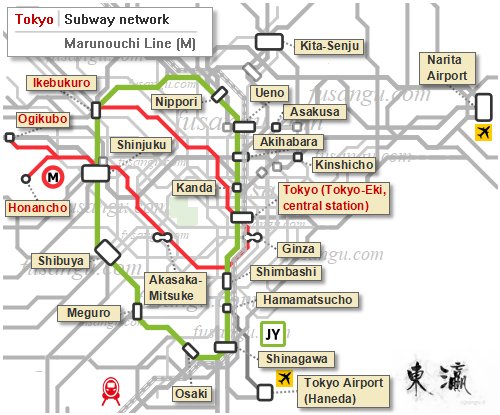
If you choose to get around in Tokyo by subway you are likely to use the Marunouchi-sen a few times. The line, managed by Tokyo Metoro, connects key areas and major transportation hubs.
In this page we describe a one-day tour along the Marunouchi Line. The article includes a programme suitable for short stays.
The Marunouchi Line (Marunouchi-sen) is managed by the main operator, Tokyo Metoro.
The line describes a semi-circular path through Ikebukuro, Marunouchi and Shinjuku. Beyond Shinjuku the link continues westwards connecting peripheral neighbouhoods.
The Marunouchi Line serves three major railway stations:
-
Tokyo Station, the city central station, main station of the national high-speed railway network. The station lies in the centre of Marunouchi, a financial district, very close to Ginza and the Imperial Palace;
-
Ikebukuro Station, main station in Toshima, around which is a dense shopping and entertainment;
-
Shinjuku Station, the core of the district of Shinjuku, one of Tokyo’s most popular entertainment and shopping districts, rich in attractions and sights.
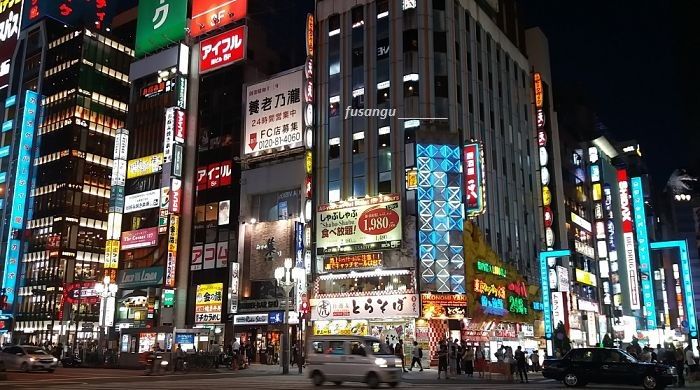
Within the main section, i.e. the loop of the Yamanote Line, the line runs through important neighbourhoods of the city centre, such as:
-
Yotsuya, neighbourhood of Shinjuku, where some interesting museums are located;
-
Bunkyo, one of the most important areas of the city centre, rich in cultural heritage and sacred sites;
-
Akasaka; a neighbourhood of Minato, a prime context where to find reasonably priced mid-range hotels. The area gives easy access to Roppongi, Aoyama, Shibuya and Chiyoda;
Beyond Shinjuku are Ogikubo and Nakano. The two neighbourhoods offer a few sights, usually included in the sightseeing tours by those who have plenty of time and wish to get off the beaten tracks.
Recommended itinerary along the Marunouchi Line
Below is the outline of a programme that suits well the needs of a first-time visitor. We assume you start your journey in Ikebukuro:
-
Ikebukuro (shopping district): 1 hour;
-
Koishikawa Koraku-En (a historic garden): 1 hour;
-
Marunouchi and Ginza (Tokyo’s city centre): 2 hours;
-
Shinjuku (Shinjuku-Gyoen Park, shopping malls, Hanazono Shrine, Tokyo Metropolitan Government observation deck, Omoide-Yokocho alley, Kabukicho): 4 hours.
Variants
It is possible to visit many more sites and areas such as:
-
Yotsuya (museums): 2 hours;
-
Hie-Jinja (a beautiful Shinto shrine): 1 hour;
-
Nakano (shopping district, a favourite hangout for manga, anime, cosplay, collectionism buffs): 2-3 hours.
Related articles:
Main article: Tokyo 3-day itinerary
Itineraries along the subway lines (Asakusa, Hibiya, Ginza, Marunouchi, Tozai, Mita, Namboku, Yurakucho, Chiyoda, Shinjuku, Hanzomon, Oedo, Fukutoshin)
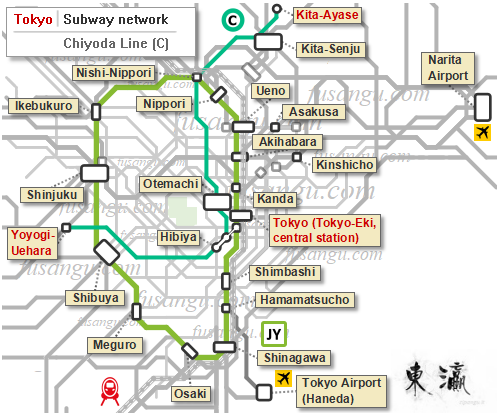
For the purpose of sightseeing, the Chiyoda-sen is among the most useful lines of Tokyo’s subway networks.
The line runs north-south connecting many of the city’s most popular tourist areas such as Bunkyo, Akihabara, Chiyoda, Minato and Shibiya.
In this page we describe a one-day tour along the Chiyoda Line. The article includes a programme suitable for short stays.
The Chiyoda Line (Chiyoda-sen) is managed by Tokyo's main subway operator, Tokyo-Metoro.
The line links many places of interest and serves important stations and transportation hubs.
Areas of interest served by the line are the following:
-
Adachi and Arakawa, peripheral districts where it is possible to find very accommodation solutions in a wide range (cheap hotel, hostels and guest houses). While the context is not particularly pleasant, these areas are a great choice for a budget traveller that plans a non-short stay;
-
Yanaka, a historic neighbourhood with an atmosphere of nostalgia;
-
Bunkyo, one of Tokyo’s most important central areas. Here are a few historical shrines and temples. The Chiyoda Line serves this area in an excellent way;
-
Akihabara, the “electric town”, a gathering place for otaku and anime and manga buffs;
-
Chiyoda, Tokyo’s central district, where the Imperial Palace and Yasukuni Shrine are located. Within the area is Otemachi Station, major subway station served by four more lines (Marunouchi, Tozai, Mita, Hanzomon lines).Tokyo Station, the city’s central railway station, can be reached on foot via an underground passage;
-
Minato, large district located south of the centre. The Chiyoda Line serves mainly the northern part, in particular Akasaka and Roppongi neighbourhoods;
-
Shibuya, major commercial district and important destination for tourists. The line serves major points of interest such as the Nezu Museum, Omotesando, Harajuku and Meiji Shrine.
It is not possible to visit all these areas in one day, especially if you wish to include in your programme visits to all major shrines, temples and museums served by the line.
If you do not mind including in your journey a few walking routes, the Chiyoda Line is a fundamental route around which an entire 3-5 day itinerary can be arranged.
Recommended itinerary along the Chiyoda Line
Below is the outline of a programme that suits well the needs of a first-time visitor. We assume you start your itinerary in Yanaka:
-
8:30 - 9:30: visit to Yanaka. Here you can visit the large cemetery, a few temples and shrines. The area is also noted for its vibrant markets and street food scene. The neighbourhood is full of small shops, street vendors and cheap restaurants. In case you want to experience its bustling atmosphere, you can postpone the visit to the late afternoon. Yanaka can be reached on foot from Sendagi Station;
-
10:15 - 11:00: visit to Nezu-Jinja, a major shinto shrine, most noted for its elegant and largely distinctive architecture. It is served by Nezu Station;
-
11:30 - 13:00: lunch break and visit to Akihabara, a little dreamland for those who love anime, manga, cosplay and electronics;
-
13:30 - 19:30: walking tour in Shibuya. You can start a walking tour from Nezu Museum, a major collection of Oriental art. You can then reach Omotesando, a large avenue lined with luxury shops and Harajuku, a gathering point for those who are into the most bizarre and eccentric trends in fashion. Next is a visit to Yoyogi Park and Meiji Shrine. You can then have dinner and spend the night in Shibuya. Around Shibuya Station are all kinds of attractions for party-goers.
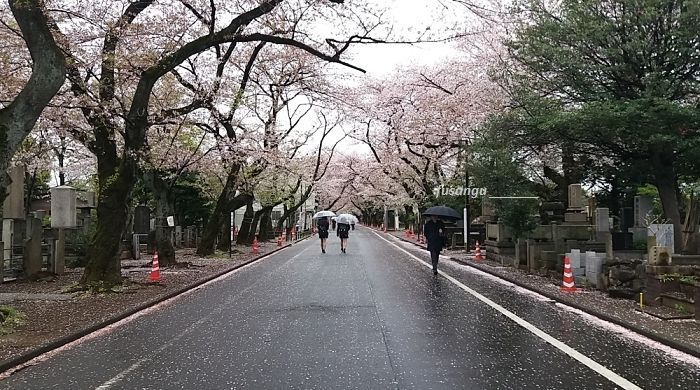
Variants
We chose an itinerary that offers a mix of experiences and attractions. Since the Chiyoda Line connects an incredible amount of places of interest, you can easily calibrate your itinerary according to your likes and needs.
Religious architecture
A few other lines connect a similar amount of major religious sites as does the Chiyoda Line. The line runs through Bunkyo and Chiyoda where you can visit important shrines and temples such as Yushima Seido, a Confucian temple, Kanda-Myojin Yushima Tenmangu, Nezu-Jinja, major shinto shrines. Not far is also Yasukuni-Jinja.
Other major shrines served by the line are Hie Shrine (served by Kokkai-gijido-mae Station) and Nogi Shrine (served by Nogizaka Station).
Ueno
Yanaka is very close to Ueno. You can therefore reach it on foot from Sendagi Station. Another option is to travel by train, along the Yamanote Line (loop line) from Nishinippori Station.
Where to stay
The Chiyoda Line connects two areas where you can find accommodation at interesting prices:
-
Adachi and Arakawa, peripheral districts, where there is plenty of cheap hotels;
-
Akasaka, an elegant neighbourhood in central Minato, a perfect location, well-served by the subway system and right in the centre of all major itineraries. The area is very close to Roppongi, which is definitely a pro if you plan on spending some nights out. In Akasaka you can find very good value for money mid-range hotels but booking in advance is crucial.
Related articles:
Main article: Tokyo 3-day itinerary
Itineraries along the subway lines (Asakusa, Hibiya, Ginza, Marunouchi, Tozai, Mita, Namboku, Yurakucho, Chiyoda, Shinjuku, Hanzomon, Oedo, Fukutoshin)
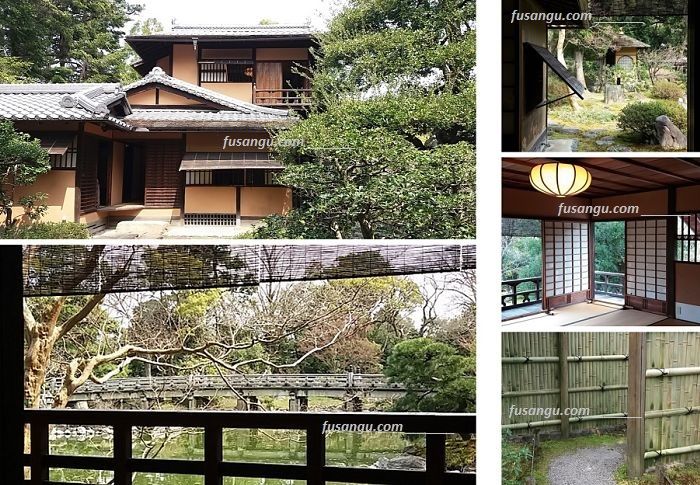
Ten days are a short period of time but they can be enough for the first journey to Japan as there is plenty of room for arranging an itinerary between Tokyo and Kyoto, the nation’s main destinations.
In this page we briefly outline a selection of ten-day itineraries along the Tokyo-Kyoto route. All itineraries are compatible with the use of a 7-day Japan Rail Pass ticket.
Contents
-
First journey to Japan (choice of the itinerary, main destinations, side trips)
-
Recommended 10-day itineraries (Kyoto and Tokyo; inclusion of a third major destination, one-day excursions from Tokyo and Kyoto)
-
Where to stay (accommodation in Tokyo, Kyoto, Kanazawa, Hiroshima)
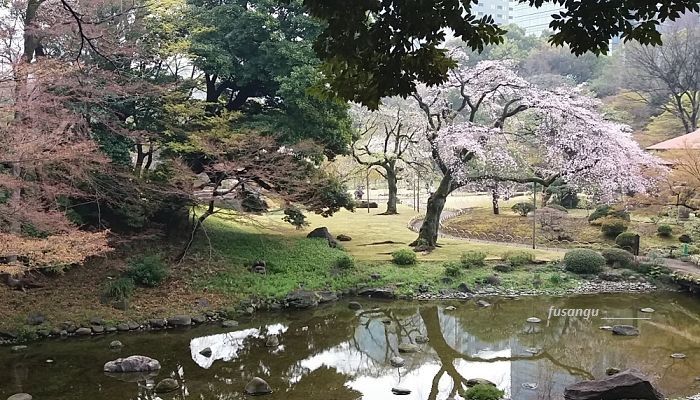
Ten days in Japan: choice of the itinerary
As already mentioned, a first journey to Japan should include both Tokyo, the current capital, a modern metropolis that offers images of a nation projected into the future with solid roots in the past, and Kyoto, the spiritual heart of the nation, a trove of sacred sites and cultural treasures. We feel that you also programme a visit to Nara, ancient capital endowed with an outstanding cultural heritage, much of which reflects the beauty of Tang China and its influence over ancient Japan. Nara can easily be visited with a one-day excursion from Kyoto.
In our opinion, these three cities should be the core of any 10-day first journey to Japan. While it would be perfectly reasonable to limit the programme to these three cities, it is still possible to add one more major destination and arrange one or two side-trips.
The programmes described below do not contemplate major natural destinations which, in our opinion, should be considered only for second-time journeys or longer itineraries.
Nevertheless, either from Tokyo or Kyoto it is possible to organise visits to a few beautiful towns set in majestic natural landscapes in the Kanto and Kansai regions. These can be arranged as one-day excursions.
All of the itineraries outlined below can easily be organised independently, without having to resort to the support of a travel agency.
Ten days in Japan: recommended itineraries
Tokyo and Kyoto are the two major destination for a 10-day itinerary in Japan. Both cities deserve long stays, ideally of at least 3-4 days. In view of this, we suggest you choose to devote an entire week, 7 days, to these two destinations.
Depending on your interests and inclinations, you may opt for a longer stay in Tokyo, if you are more interested in modern Japan, or in Kyoto, if you are fascinated with ancient and traditional culture and art.
The remaining 2-3 days can be used for side-trips.
You should take into account that transfers between Tokyo and Kyoto can take up to two half days. If you are on a budget and you are comfortable with such a tough way of travelling, you can opt for night transfers by bus. This will allow you to save time and money.
Here are the suggested itineraries:
Itinerary 1: Tokyo, Kyoto with side-trips from both cities;
Itinerary 2: Tokyo, Kanazawa, Kyoto
Itinerary 3: Tokyo, Kyoto, Hiroshima
Itinerary 4: Tokyo, Takayama, Kanazawa, Kyoto
We assume that Narita Airport (near Tokyo) is the point of arrival and departure. Another option is to enter and exit the country through Kansai Airport (near Osaka and Kyoto).
If you travel from Asia you may also consider other points of entry such as the airports of Hiroshima, Nagoya and Okayama.
Itinerary 1: Tokyo and Kyoto
If you do not feel comfortable with tight schedules and enjoy slow travelling and the possibility of improvising and letting the journey lead you, you may choose to plan to visit only Tokyo and Kyoto. You can allocate time in many different ways. We suggest spending 4 days in Tokyo and 6 days in Kyoto (or the wider Kansai Region area, which includes Osaka, Nara, Kobe and many other destinations).
Transfers between the two cities take around 3 hours. Therefore, if you travel in the early morning or late afternoon, you will not waste time.
From both cities you can easily arrange side-trips. All transfers can be made by train or by bus. You can also join group tours, which are getting cheaper and cheaper.
As for day-trips, there is plenty of choice:
-
From Tokyo: Nikko, Kamakura, Hakone,Mount Fuji and the Five Lake Region
-
From Kyoto: Nara, Osaka, Himeji, Uji, Mount Koya
How to organise the transfers
If you choose a round trip flight itinerary (entry and exit through the same airport, typically Narita Airport), it would pay off to make use of a 7-day Japan Rail Pass ticket. This has to be activated on the fourth day of the journey, so as to cover the transfers of the last 7 days of the itinerary:
-
Tokyo-Kyoto: (by shinkansen, Hikari)
-
Excursions from Kyoto: (such as Kyoto-Osaka, Kyoto-Nara, Kyoto-Himeji; transfers between Kyoto and Koyasan are covered by the specific tourist ticket, Koyasan World Heritage Pass)
-
Kyoto-Tokyo: (by shinkansen, Hikari)
-
Tokyo-Narita Airport: (by N’EX, Narita Express, the fastest option)
Itinerary 2: Tokyo, Kanazawa and Kyoto
If you are into traditional culture and strive to see images of ancient Japan, you would struggle to count out a visit to Kanazawa. Together with Kyoto, Kanazawa is one of the few major cities of Japan that were not ravaged during WWII. As such, the city boasts a unique historical centre that comprises a few neighbourhoods, the chaya districts, that retain the beauty and harmony of the traditional architecture. Narrow alleys, wooden buildings, a quaint atmosphere, abundance of green areas and sacred sites, Kanazawa is a fascinating city where you could easily spend 2-3 days. A full day can be spent for visiting Kenroku-En, a magnificent landscape garden, the Kanazawa-Jo, an elegant castle, and one chaya district. A half day can be spent to visit Nagamachi, the samurai district.
Kanazawa is located in the Chubu Region, which lies between Kanto and Kansai. This means you can visit Kanazawa as an intermediate destination along the journey between Tokyo and Kyoto. Moreover, you can take advantage of a new pass, which covers transfers between Tokyo, Kansai through Hokuriku Region (where Kanazawa is located). You can allocate time in many different ways. We suggest spending 3 and a half days in Tokyo, 1 and a half days in Kanazawa, and 5 days in Kyoto (or the wider Kansai Region area, which includes Osaka, Nara, Kobe and many other destinations).
As for day-trips, we suggest the following destinations:
-
From Tokyo: Nikko or Kamakura
-
From Kyoto: Nara, Osaka, Himeji, Uji, Mount Koya
How to organise the transfers
If you choose a round trip flight itinerary (entry and exit through the same airport, typically Narita Airport), it would pay off to make use of a 7-day Hokuriku Japan Rail Pass ticket. This is cheaper than the regular 7-day nationwide Japan Rail Pass.
The pass has to be activated on the fourth day of the journey, so as to cover the transfers of the last 7 days of the itinerary:
-
Tokyo-Kanazawa: (by shinkansen)
-
Kanazawa-Kyoto: (by limited express)
-
Excursions from Kyoto: (such as Kyoto-Osaka, Kyoto-Nara, Kyoto-Himeji; transfers between Kyoto and Koyasan are covered by the specific tourist ticket, Koyasan World Heritage Pass)
-
Kyoto-Tokyo: (by limited express and shinkansen, through Kanazawa)
-
Tokyo-Narita Airport: (by N’EX, Narita Express, the fastest option)
The only drawback is that all Tokyo-Kyoto transfers require passing through Kanazawa, which means you cannot travel along the direct Tokyo-Kyoto Tokaido Shinkansen Line. This indirect transfer takes around 5 hours instead of the typical 3 hours of the direct route.
Itinerary 3: Tokyo, Kyoto and Hiroshima
If you wish to visit Hiroshima, you can still do this on a 10-day journey, even though this requires making the schedule quite tight. You can allocate time in many different ways. We suggest spending 3 and a half days in Tokyo, 2 days in Hiroshima and Miyajima and 3 and a half days in Kyoto.
Transfers between the Hiroshima and Kyoto take around two and a half hours. Therefore, if you travel in the early morning or late afternoon, you will not waste time. The longer Tokyo-Hiroshima transfer takes around 5 hours and it does take a half-day. The final Kyoto-Tokyo transfer takes around 3 hours, which makes it possible to enjoy a final full day in Kyoto.
As the schedule is tight we suggest considering only the following day-trips:
-
From Tokyo: Nikko or Kamakura
-
From Kyoto: Nara
Along the transfer between Kyoto and Hiroshima you may add stops at Okayama, where you can visit the Koraku-En Garden and Himeji, small town famed for its huge and majestic castle.
How to organise the transfers
If you choose a round trip flight itinerary (entry and exit through the same airport, typically Narita Airport), it would pay off to make use of a 7-day Japan Rail Pass ticket. This has to be activated on the fourth day of the journey, so as to cover the transfers of the last 7 days of the itinerary:
-
Tokyo-Hiroshima: (by shinkansen, Hikari and Sakura, a transfer is required at Osaka or Kobe)
-
Hiroshima-Kyoto: (by shinkansen, Sakura)
-
Excursions from Kyoto: (such as Kyoto-Osaka, Kyoto-Nara)
-
Kyoto-Tokyo: (by shinkansen, Hikari)
-
Tokyo-Narita Airport: (by N’EX, Narita Express, the fastest option)
Itinerary 4: Tokyo, Takayama, Kanazawa and Kyoto
If you travel to Japan in winter you may want to see the snow. In this case beside Kanazawa, which lies at the centre of the so called Yukiguni (“the land of snow”) you may add a short stay in Hida-Takayama, a small town where you can appreciate beautiful traditional vernacular architecture as well as a few shrines and a museum. Takayama is also an ideal starting point for an excursion to Shirakawa-go, a picturesque village characterised by old wooden houses built in a distinctive architectural style. Their roofs evokes the shape of joint hands in the act of praying. The small village still retains the serene and peaceful atmosphere of a world where time flows slowly in never ending cycles.
An itinerary of this sort is kind of demanding and it requires a tight schedule. We suggest spending 3 and days in Tokyo, 1 and a half days in Takayama (including a day-trip to Shirakawa-go), 1 and a half days in Kanazawa and 3 and a half days in Kyoto.
Two half days are absorbed by the longest transfers, i.e., Tokyo-Takayama and Takayama-Kanazawa. You can travel between Kanazawa and Kyoto and between Kyoto and Tokyo in the late afternoon, which will allow you to save time.
As for the other day-trips, we suggest considering the following destinations:
-
From Tokyo: Nikko or Kamakura
-
From Kyoto: Nara
How to organise the transfers
If you choose a round trip flight itinerary (entry and exit through the same airport, typically Narita Airport), it would pay off to make use of a 7-day Japan Rail Pass ticket, the regular nationwide one. The pass has to be activated on the fourth day of the journey, so as to cover the transfers of the last 7 days of the itinerary:
-
Tokyo-Takayama: (by shinkansen and ordinary train, via Nagoya)
-
Takayama-Kanazawa: (by ordinary train and shinkansen, via Toyama)
-
Kanazawa-Kyoto: (by limited express)
-
Excursions from Kyoto: (Kyoto-Nara or Kyoto-Osaka)
-
Kyoto-Tokyo: (by limited express and shinkansen, through Kanazawa)
-
Tokyo-Narita Airport: (by N’EX, Narita Express, the fastest option)
How to organise the transfers
Travelling by train is by far the best way to get around for the itineraries presented above. A cheaper but much less comfortable option is offered by night buses.
Travelling by plane can be a reasonable option only for transfers between Tokyo and Hiroshima.
Japan Rail Pass tickets
After the sharp increase in prices, nation-wide Japan Rail Pass (particularly the 7-day pass) no longer pay off for ordinary itineraries like the ones described in this page. You may want to consider the opportunity of buying regional passes, depending the itinerary of your choice.
By far, the best regional pass for journeys along the Tokyo-Kyoto route is the JR Hokuriku Arch Pass, which allows for unlimited travel between Tokyo, Kyoto, Osaka via Kanazawa for 7 consecutive days.
Multi-city flight itineraries
If you find convenient flight itineraries with entry through Tokyo and exit through Osaka you will not need to buy a JR Pass.
Where to stay
All cities mentioned in this page offer a wide range of accommodation, including hostels, cheap hotels, traditional inns and guest houses catering for families and groups.
In general, Kanazawa and Takayama offer the best deals if you are seeking the unique experience of staying in a ryokan, the Japanese traditional inn, in our opinion a cultural experience that should not be missed out on.
In Tokyo
For stays in Tokyo of 3 or 4 days we suggest you find accommodation in a neighbourhood conveniently served by the subway and railway networks. Popular choices are the following:
-
Asakusa, the heart of the old shitamachi, a quaint neighbourhood well served by connections by train with Narita Airport, the main tourist areas and the centre. Trains to Nikko depart from Asakusa Station. In Asakusa there is plenty of hostels, cheap hotels and a few inexpensive traditional inns;
-
Ueno, the best location as for convenience of the location, important transportation hub, conveniently served by the Yamanote loop line;
-
Shinjuku, the core of the modern city, a primary night life centre;
Other areas to be considered are Akasaka, a quiet area in the centre, well connected to all major districts in Tokyo, and Edogawa, a little farther from the centre, ideal for those who seek cheaper options.
In Kyoto
For stays in Kyoto of 3-5 days we suggest you choose among the following locations:
-
Kyoto Station, near the central station, the basic option, suitable to those who value convenience of the position;
-
Gion (Higashiyama), in the heart of the historic city, a fascinating context, the best possible choice for those who want to enjoy exploring the city at dawn or sunset, free from the inconveniences brought by large crowds. As you can easily imagine, such a choice requires advance booking and in general it implies higher costs;
-
Kamigyo, a quaint neighbourhood of the ordinary city, far from the tourist bubbles but close to many attractions and perfectly served by the main bus routes. This is an ideal choice for those who want to experience staying at a cheap guest house. Most of structures located in Kamigyo are family run and offer a genuine cultural experience. Many cater to families. If you stay here you can also get around by bicycle, a good way to explore the area and the rest of the city.
In Kanazawa
In Kanazawa you can find good hotels and traditional ryokans around Higashichaya, atmospheric traditional district where you will enjoy amazing night walks. A good second choice, more practical, is to stay near Kanazawa Station.
In Takayama
Takayama is a very small town. There is no need to focus on any specific area. Choice of a place to stay at will essentially depend on the quality of experience that you want to have.
In Hiroshima
There is plenty of hostels and hotels near Hiroshima Station, perfect location for a short stay in the city. A pleasant alternative is to spend a night in Miyajima, where you can find very good, albeit quite expensive, ryokan.
Related articles:
Itineraries in Japan: 5 days | 7 days | 14 days
First journey to Japan: Ten-day classic itinerary
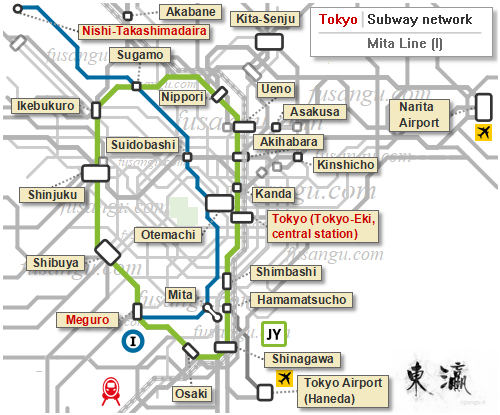
The Mita-sen is one of the four subway lines managed by Toei, Tokyo’s municipal transportation company.
The long line describes a semicircular path along a north-south route. In the centre the line connects some of the city’s most popular tourist areas such as Bunkyo, Chiyoda, Minato and Meguro.
In this page we describe a one-day tour along the Mita Line. The article includes programmes that are suitable for those who are in Tokyo for periods longer than 3-4 days.
The Mita Line passes through some of the most important neighbourhoods in the centre of Tokyo. The line intersects twice the JR Yamanote Line (the railway loop line) in Meguro and Sugamo.
While very effective in linking areas of the centre, the line is most often used by visitors who stay in Tokyo for periods longer than 4-5 days. This is because the line is particularly useful to those who visit Bunkyo and Minato, areas that are often included in long stays.
Major stations along the Mita Line
The Mita Line is runs along a north-south direction. Between Sugamo and Meguro, namely in the section of utmost interest for a visitor, the line describes a semi-circular route through the core of the city centre, i.e., Hibiya.
Station to be noted are at least the following (from north to south):
-
Sugamo, a small neighbourhood known as the “Harajuku of the Elderly”. The station is also served by the Yamanote Line. Rikugi-En, one of Tokyo’s most beautiful gardens, is very close to Sugamo Station;
-
Kasuga, in the centre of Bunkyo District, a major transfer station (connection with Marunouchi, Namboku and Oedo lines). The station is close to Koishikawa Koraku-En, a magnificent garden. Very close are also Kodokan, Japan’s Judo headquarters and Tokyo Domu, an entertainment complex;
-
Suidobashi, a station that gives access to Kanda, a interesting neighbourhood in the centre of Tokyo. Near the station are some of Tokyo’s most prestigious universities as well as Ochanomizu and Jimbocho areas. Many good value for money mid-range hotels are located near this station;
-
Jimbocho, a neighbourhood famous for the presence of large shops selling musical instruments and bookshops. Connection with Shinjuku and Hanzomon lines;
-
Otemachi, huge station served by four more lines (Marunouchi, Tozai, Chiyoda, Hanzomon lines).Tokyo Station, the city’s central railway station, can be reached on foot via an underground passage;
- Hibiya: near the Imperial Palace, Hibiya Park and some of the city’s most prestigious hotels (Imperial Hotel, Peninsula Hotel);
-
Shibakoen, near Shiba Park, in Minato District. Here are Zojo-Ji Temple and Tokyo Tower (a communication and observation structure, vaguely resembling a small Eiffel Tower). Not to be missed is also Shiba Tosho-gu, a beautiful shrine built with the distinctive Toshogu style. The park is also home to an ancient ginkgo tree, believed to have been planted by Tokugawa Iemitsu himself.
-
Meguro, main station of the district. The station is not far from Meguro-gawa, a must-see cherry blossom spot. Connection with Yamanote Line.
Recommended itineraries along the Mita Line
Below we give brief descriptions of two interesting itineraries along the Mita Line. We have focused on destinations that are particularly interesting to those who visit Tokyo for the first time.
From Sugamo to Meguro through Bunkyo and Minato
Below is a programme with starting point in Sugamo, station conveniently served by the Yamanote Line (loop line).
Choosing a different sequence of visits poses no difficulty. The programme is very suitable also for those who wish to find accommodation in the centre of Tokyo (Kanda, Marunouchi, Akasaka).
As a few rides are needed, we suggest you buy a subway day pass.
Programme:
-
9:00 - 10:00: a short walk from Sugamo Station takes to Rikugi-En garden, a wonderful landscape gardens comprising 88 scenes of ancient poetry;
-
10:00 - 13:00: transfer to Kasuga Station. You can then reach on foot Koishikawa Koraku-En, one of Tokyo’s main traditional gardens. After the visit (which should last at least half an hour) you can spend some time and have lunch at Tokyu Domu entertainment complex. In spring you can go past the station until you reach Sotobori Park. This is a pleasant park full of cherry trees;
-
13:30 - 15:30: transfer to Shibakoen Station. From the station you can walk to Shiba Park. Make sure you visit at least Zojo-Ji and Shiba Toshogu, two places of worship of outstanding architecture. You can also visit Tokyo Tower and have a look at the city from the observation deck;
-
16:00 - 19:00: visit to the Tokyo’s city centre. You can complete your tour by visiting Ginza. In spring we suggest you reach the terminal station, Meguro, from which you can walk to Meguro-gawa, a major attraction during the cherry blossom.
Variants
As the Mita Line runs through the city centre, there is plenty of choice as for destinations:
Marunouchi
You can add a visit to Marunouchi, core of the centre of Tokyo. You can reach it easily on foot from Otemachi Station. Marunouchi is famous for its upscale shopping departments and Tokyo Station. The area is rich in museums.
Chiyoda
Another option is to have a walk along the perimeter of the Imperial Palace. You can visit the gardens which are open to the public and take a stroll in Chidorigafuchi, another major cherry blossom viewing spots. If you enjoy walking you can reach Yasukuni-Jinja.
Minato
Another option is to alight at Shirokanedai Station, visit the Institute for Nature Studies and continue on foot to Meguro-gawa. This can make for an exciting walking tour. Along the path you can find quite a few shrines and temples, some of which important but seldom visited by tourists.
Related articles:
Main article: Tokyo 3-day itinerary
Itineraries along the subway lines (Asakusa, Hibiya, Ginza, Marunouchi, Tozai, Mita, Namboku, Yurakucho, Chiyoda, Shinjuku, Hanzomon, Oedo, Fukutoshin)
Page 2 of 8
